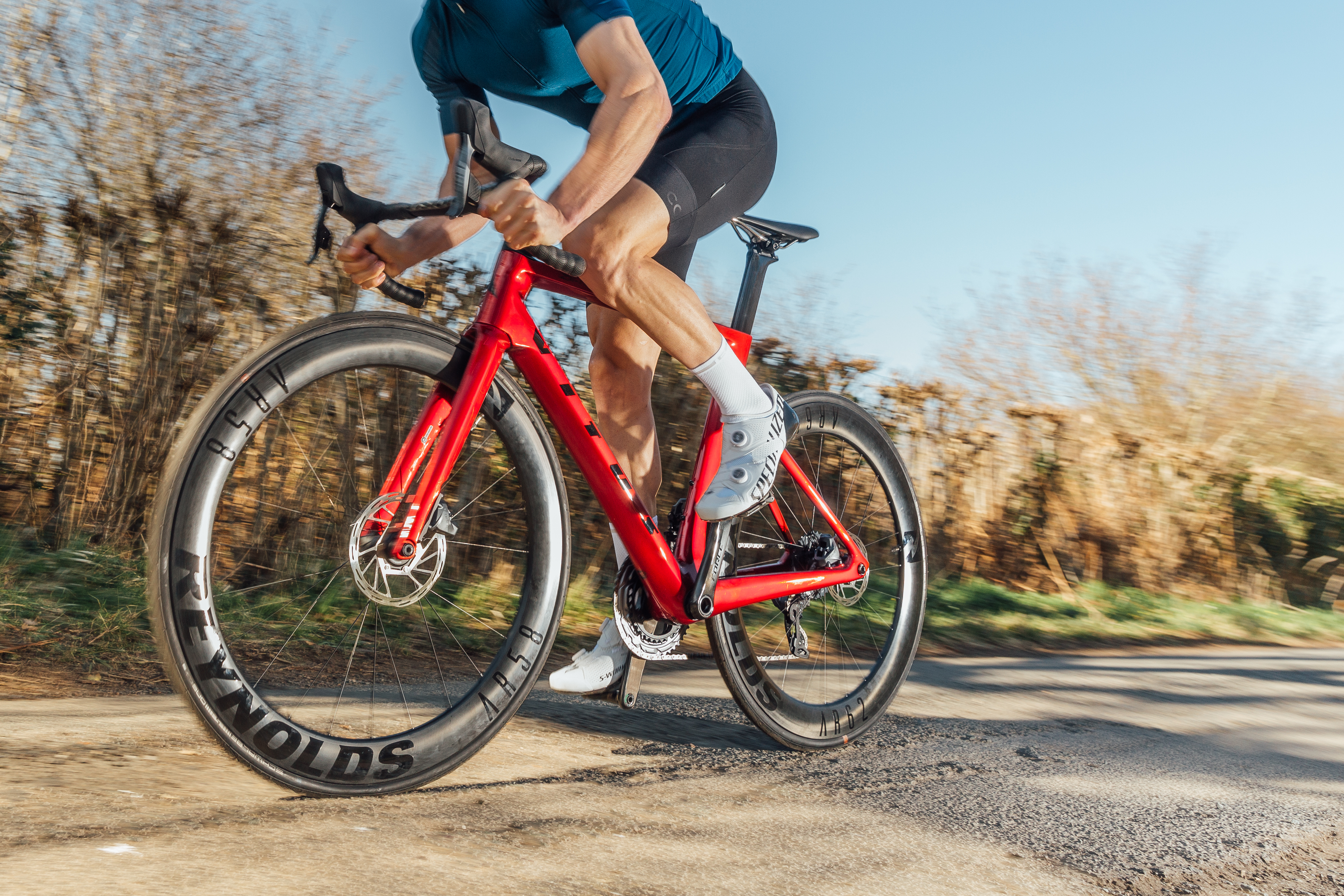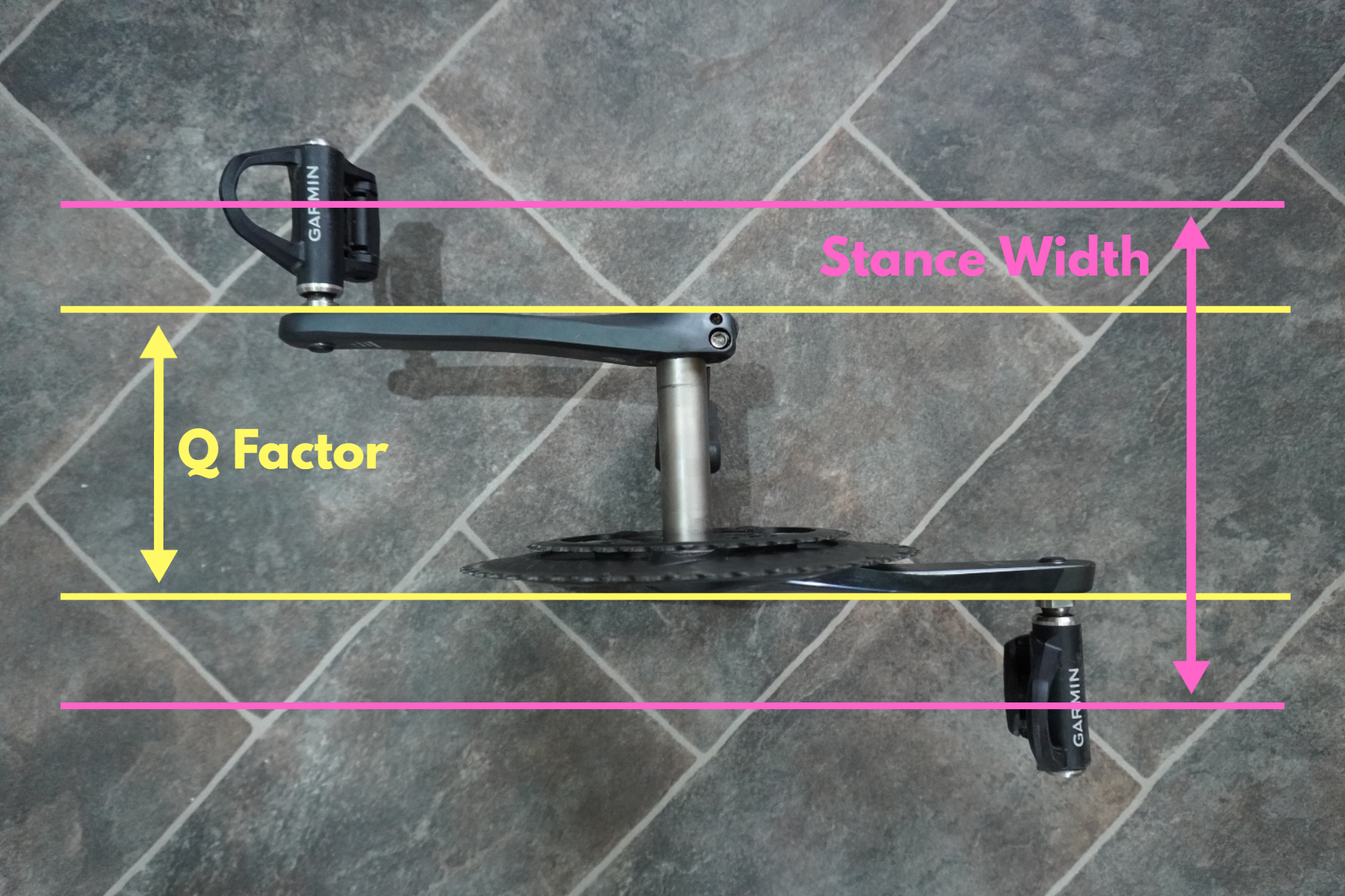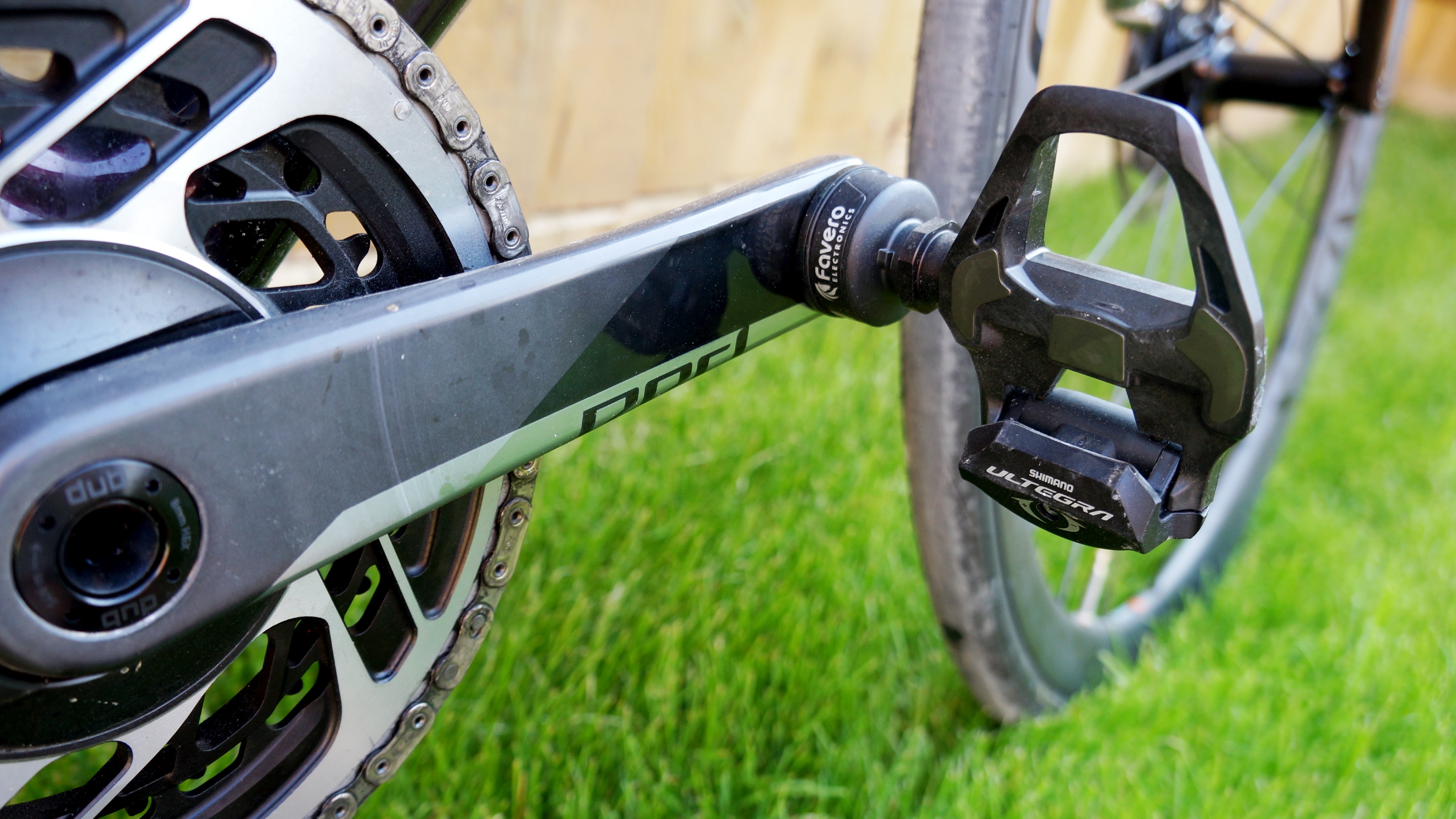Could altering your Q Factor make you more comfortable - or faster - on the bike?
Find out how you can adjust your stance width to stay injury free and go faster

Before going any further we should define what is meant by Q Factor. Sometimes known as 'quack factor' (a references to ducks and their waddle-y legs), Q Factor is the distance between the outside of one crank arm to the outside of the other.
This is an important bike fit parameter as it effects your stance width, which is how far apart your feet end up being when placed on your pedals. We'll get into the details on the risks of an incorrect stance width, how to determine the right stance width for you, and how to adjust the stance width on your bike.
It's worth just noting that beyond just the Q Factor of your cranks, there is a range of other factors that determine your stance width. Your pedal spindle length, how you mount your cleats to your shoes, and even spacers between the pedal and the crank all give scope for altering the distance between your feet without changing your Q Factor.

Why is Q Factor important?
Cycling is a highly repetitive sport with thousands of pedal strokes per hour, making cyclists susceptible to overuse or overload injuries. Ideally, we want the hip, knee and foot to operate in a straight line, and this alignment can be assessed by observing knee tracking.
With the foot fixed to the pedal (bar a few degrees of float in the cleat), and the hip relatively fixed to the saddle, an inappropriate stance width where the hip, knee and foot are not in good alignment may place torque through the knee, which can result in discomfort or injury.
Direct application of force can also improve your power production and efficiency. Since the foot is fixed, as is our pelvis width, we need to align the foot with the knee, not the other way around.
Humans are also rarely perfectly symmetrical in structure or movement/coordination, whereas bikes are symmetrical. Therefore you may find your single leg stance width varies from one leg to the other.
As an aside, Q Factor is not to be confused with Q Angle, or quadriceps angle, which is an anatomical feature of the person. This instead refers to the angle between the thigh bone and shin bones measured by drawing a line through the knee cap.

How do you increase stance width?
Q Factor is dependent on the bike and its components - bottom bracket width, crank brand and model - and is not easily changeable. A typical bottom bracket width is 68mm for a road bike and 73mm for a MTB, and Q-factor tends to be around 150mm for a road bike and 170mm for a MTB.
That larger Q-factor on a MTB is down to the wider tyres which forces the cranks further out for clearance and to maintain chain lines.
As the Q Factor is set by the bike, the way to manipulate stance width is through the pedals and adjusting the cleat position on your cycling shoes.
Adjust your cleat position
Both road and MTB cleats will give you some side to side adjustment, between 4-6mm. To widen your stance width you should place your cleat towards the inside of your shoes.
Looking to decrease your stance width? The only way to do this (without swapping out the crankset) is via the cleats, by moving them to the outside of the shoe.
Shoes can also influence stance width by where the cleats holes are drilled in the sole. Whilst this is also unadjustable, it may need to be considered when changing shoes.
Pay attention to pedal spindle length
Pedals have different spindle lengths, with Shimano and Wahoo Speedplay offering wider options for those who need a larger stance width.
Another option is to fit pedal washers or pedal extenders. Pedal washers are 1.5mm each, and you can fit a maximum of two (3mm total) and still have enough thread to safely screw in the pedal.
Pedal extenders add 20mm more width, which is quite a significant amount, although this can be offset somewhat by adjusting the cleat.
One thing to note is the huge increase in pedal spindle width between the Look-compatible Favero Assioma power meter pedals, and the Shimano-compatible ones (54mm vs 65mm). Those who need a narrow stance width may experience issues with a 65mm pedal spindle width.
| Pedal | Type | Spindle Length | Options |
|---|---|---|---|
| Shimano SPD-SL | Road | 52mm | + 4mm = 56mm |
| Look Keo | Road | 53mm | Row 1 - Cell 3 |
| Wahoo Speedplay | Road | 53mm | 56/59/65mm |
| Garmin Rally | Road power meter | 53mm | Row 3 - Cell 3 |
| Favero Assioma | Road power meter | 54mm | Row 4 - Cell 3 |
| Favero Assioma Shimano | Road power meter | 65mm | Row 5 - Cell 3 |
| Wahoo Speedplay Powrlink | Road power meter | 55mm | Row 6 - Cell 3 |
| Shimano XTR | MTB | 52mm | 55mm |
| Crank Brothers | MTB | 52mm | Row 8 - Cell 3 |
How to tell you need to adjust your stance width
Stance is self-selected, influenced by posture, habit and anatomical features. Your lower limb alignment, such as if you have bowed legs (genu varum), knock knees (genuvalgum) or a large Q-angle, can effect your ideal stance width.
A wide, toe-out stance in everyday life may indicate the need for a wider stance width on the bike, although this is not always the case. Checking your stance during a squat on two legs and one leg may also give further clues on your loading pattern. Stiff hips can also indicate the need for a wider stance, especially if you are lacking flexion and internal rotation.
To determine whether changes will need to be made, observation of your pedalling on the bike is essential. Knees kicking out during the pedal stroke can indicate a stance width that is too narrow, knees dropping in can mean the stance width is too wide.
However, poor knee tracking can be due to factors other than stance width. A saddle height that is too low or too far back can result in a closed off hip angle, forcing the knees to kick out at the top of the pedal stroke if the hip does not have sufficient range of movement.
Get The Leadout Newsletter
The latest race content, interviews, features, reviews and expert buying guides, direct to your inbox!
Cranks that are too long can also have this effect, particularly in those with stiff hips. Poor control of rotation or muscle imbalance at the hip can also effect knee tracking and alignment, as can poor foot stability. Therefore stance width needs to be considered and adjusted as part of the bike fit as a whole. Issues such as stiff hips and poor muscle control may need to be addressed off the bike.
The majority of time I find that stance width needs to be widened rather than narrowed, and there is an argument that the Q-factor of road bikes are just not wide enough for the general population. Occasionally, the stance width will not be able to be made narrow enough, usually in those of small stature, which is more often women.
Common issues from incorrect stance width
The knee is the most likely area to experience discomfort or injury with an inappropriate stance width. The most common knee pain issue when stance width is too narrow is pain on the outside of the knee, often involving the ITB, due to strain being placed on these lateral structures.
The patellofemoral (knee cap) joint can also be irritated by torque force/twisting being applied to the knee when the stance width is too narrow or too wide, causing increased compression on the medial or lateral structures under the knee cap.
Another issue may be pain or numbness on the outside of the foot as it tries to push out against the shoe.
Can adjusting stance width make you faster?
A narrower stance width may be marginally more aerodynamic, but often is unsustainable to give a performance benefit. Perhaps it could be beneficial in short track events such as the pursuit, but again will largely depend on individual factors.
Ultimately, a stance width that allows you to apply power directly down through your driving leg will generally be more efficient and comfortable, allowing you to continue to cycle without pain or injury for longer, allowing you to get faster!
Stance width should be adjusted to what suits your biomechanical and anatomical needs. which will optimise comfort, performance, and prevent injury. The aim is to achieve good hip, knee and foot alignment by aligning the foot to the knee. Since Q Factor is largely determined by the bike and components, this is done by making adjustments to the pedals and cleats, as well as ensuring the overall bike fit is appropriate.

Thank you for reading 20 articles this month* Join now for unlimited access
Enjoy your first month for just £1 / $1 / €1
*Read 5 free articles per month without a subscription

Join now for unlimited access
Try first month for just £1 / $1 / €1
Nicole Oh is a physiotherapist and bike fitter, with training in biomechanical assessments, sports injury rehabilitation, acupuncture and clinical pilates.
A competitive cyclist with a background in triathlon, Nicole raced at National level in the UK, also managing and co-founding the Les Filles Racing Team. Having moved to Sydney, she works as a physiotherapist at The Body Mechanic and continues to race competitively.
-
 Aero bikes with gravel wheels?: Six tech insights from Paris-Roubaix Femmes
Aero bikes with gravel wheels?: Six tech insights from Paris-Roubaix FemmesEverything we found out about tyre widths, self-inflating systems, and wheel choices from the cobbled Monument
By Tom Davidson Published
-
 'This race is absolutely disgusting': Peloton reacts to another brutal Paris-Roubaix Femmes
'This race is absolutely disgusting': Peloton reacts to another brutal Paris-Roubaix FemmesNow in its fifth edition, Paris-Roubaix Femmes is still a tough race, even for the best bike riders in the world
By Adam Becket Published